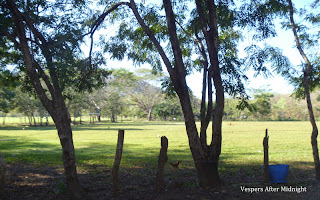And Last Minute Random Thoughts. . .
Our time in Nicaragua is fast drawing to a close. Many memories were made here, both in the field while mist netting and around the villa and town.
 |
| El Mercado. One of my favorite places to visit with the smell of cooking chorizo and the colorful fruits and vegetables. |
The results of our mist netting surveys are still being compiled, but over the 2 months of the project 1,476 individual bats representing 45 species were captured. Our captures have resulted in expansions of the known ranges of several bat species and documented a species new to Nicaragua.
 |
| Range map after our capture of a Pale-Faced Bat. |
 |
| Pale-Faced Bat (Phylloderma stenops). This is the first individual of this species captured in Nicaragua! |
The natural resources of Nicaragua are stunningly beautiful but extremely threatened. Conservation of these resources hinges on understanding the culture and economic hardships that a majority of Nicaraguans face on a daily basis. A “thou shall not destroy your resources approach” will fail here.
 |
| One of Nicaragua's many volcanoes, unfortunately I do not remember which one this is. |
Communication was an exciting challenge as the U.S. bat biologists spoke little Spanish and our Nicaraguan crew spoke little English. Our conversations were a blend of the few words we knew of Spanish/English (depending on your native language), Spanglish, biological names, and Charades. Carol and Martin, in particular, were extremely good at Charades. Had we actually played the game, they would have served as our captains.
 |
| The game "Angry Birds" was a big hit with the kids. Victor learned it within a few minutes and attained the advanced levels within one day. |
I love the beginning of a journey. One never knows quite what to expect or how to completely prepare for it. I’ve found that it is best to let go at a certain point and let the experience take you wherever it may.
 |
| So many destinations, so little time. |
The things I will miss most are not necessarily specific events, but the small moments that collectively created a backdrop for our time here. For instance, how the buildings naturally open to the sunshine and allow for a cross breeze while protecting you from the rain. I will miss the roar of the howler monkeys and the shrieks of the parrots. I will miss the colors that are so vividly displayed on every available surface. I will miss the smiles that come so quickly to the faces of Nicaraguans.
 |
| We drew many smiles from people as we transported our pinata home from the market. The pinata was stuffed with candy and sacrificed at our going away party. |
Unfortunately it is time to say goodbye to Nicaragua, but I am comforted to know that the end of this journey means the beginning of another. And it’s possible that that new journey might just lead me back here.
 |
| Minutes after sunset on our last night in San Juan del Sur. We toasted the sun and each other for a job well done. |





















